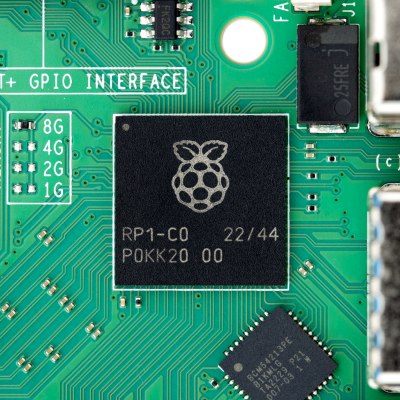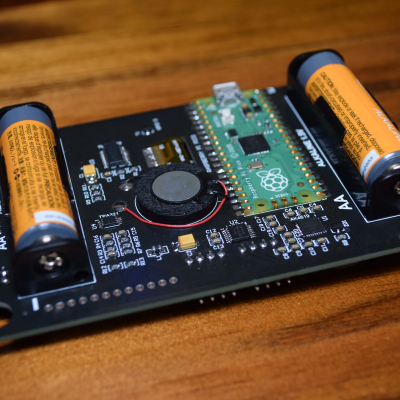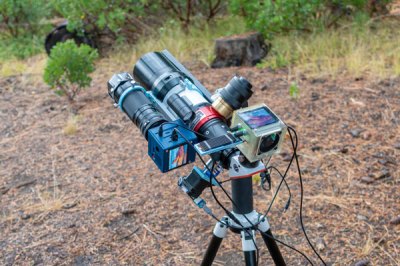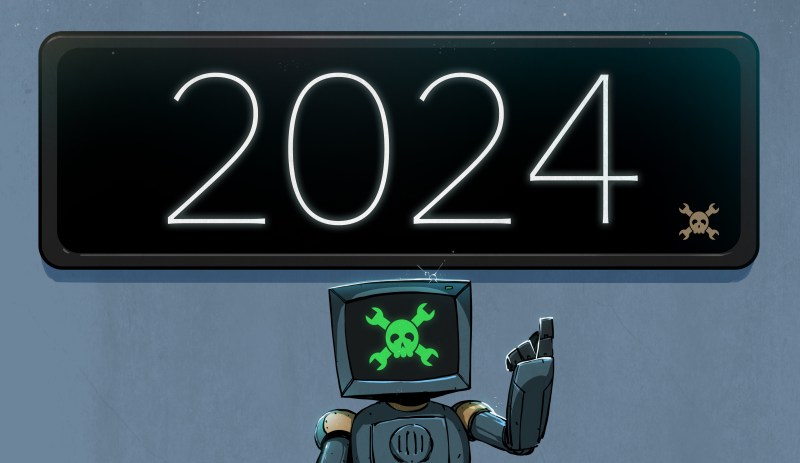We’ve made it through another trip around the sun, and for the first time in what feels like far too long, it seems like things went pretty well for the hackers and makers of the world. Like so many, our community suffered through a rough couple of years: from the part shortages that made building even the simplest of devices more expensive and difficult than it should have been, to the COVID-mandated social distancing that robbed us of our favorite meetups. But when looking back on the last twelve months, most of the news was refreshingly positive.

Oh sure, a trip to to the grocery store can lead to a minor existential crisis at the register, but there’s not much we at Hackaday can do about that other than recommend you some good hydroponics projects to help get your own home farm up and running.
As has become our New Year tradition, we like to take this time to go over some of the biggest stories and trends that we picked up on from our unique vantage point. Some will be obvious, but there’s always a few that sneak up on us. These posts tend to make for interesting reading in the future, and if you’ve got the time, we’d recommend going back and reading the previous entries in this series and reminiscing a bit.
It’s also a good time to reflect on Hackaday itself — how we’ve grown, the things that have changed, and perhaps what we can do better going forward. Believe it or not we do read all of the feedback from the community, whether it’s in the comments of individual posts or sent into us directly. We couldn’t do this without readers like you, so please drop us a line and let us know what you’re thinking.
So before we get any farther into 2024, let’s wind back the clock and revisit some of the highlights from the previous year.
AI is Everywhere
This one might seem like kind of a cop out since the growing mainstream adoption of AI-enabled tools was a big part of 2022’s review, but it’s difficult to overstate just how fast things have been moving in this space. Last year might have unleashed ChatGPT, but in 2023, everybody is jumping on the bandwagon and coming out with their own artificial intelligence products — from Google’s hilariously behind-the-ball Bard to your local Chevy dealer.
But more importantly, it wasn’t just the big players that embraced AI this year. We saw many projects from this community that either included some machine learning component or were developed in conjunction with an AI tool. It was used to generate 3D models in OpenSCAD, and help program a lawn-cutting robot. An AI keyboard took third place in this year’s Halloween Contest, Al Williams asked Google’s NotebookLM to read the documentation for the Supercon badge, and Dan Maloney tried to build a chicken coop with ChatGPT.
It’s getting to the point that it can be difficult to see where the human ends and the AI begins, which naturally opens up a whole new world of problems. Given the waves AI has made in 2022 and 2023, this upcoming year should prove to be particularly interesting (or terrifying).
USB-C Reaches Critical Mass
 We’ve been big proponents of USB-C here at Hackaday for several years. But for all our cheerleading, it was clear that not everyone in the community was ready to make the switch. Whether it was just the momentum of older tech, or the perceived complexity of the new C standard, there were plenty in the community that were happy to stick with what they already had.
We’ve been big proponents of USB-C here at Hackaday for several years. But for all our cheerleading, it was clear that not everyone in the community was ready to make the switch. Whether it was just the momentum of older tech, or the perceived complexity of the new C standard, there were plenty in the community that were happy to stick with what they already had.
Looking back on the articles from 2023, you can clearly see the last holdouts from Team Micro USB are starting to pack it up. On a quick count, it looks like we ran more than 100 articles mentioning the reversible connector in 2023, and there’s no sign of things slowing down for 2024. We’ve seen it used in everything from custom bike horns and DIY cable testers, to electronic pens and open source headphones.
In 2023 we also saw several new entries in our ongoing All About USB-C series, as well as the beginning of the new USB-C For Hackers series, both helmed by Arya Voronova. If you’ve ever wanted to add USB-C support to your own projects, or just learn more about how the interface and its various capabilities work, they are a phenomenal resource.
Small Steps Towards the Moon
Most experts are skeptical about NASA’s ability to keep the Artemis program on schedule over the next several years, but given how many stories we covered in 2023 about the space agency’s lunar program, there’s no question that things are at least moving forward.
 Compared to the grand spectacle of Apollo, the Artemis program can seem a bit…boring in comparison. But that’s only because it’s a multi-faceted endeavor which combines the contributions of private companies and international partners. There’s so many moving parts to keep track of that, unless you’re looking closely, they might not even seem related.
Compared to the grand spectacle of Apollo, the Artemis program can seem a bit…boring in comparison. But that’s only because it’s a multi-faceted endeavor which combines the contributions of private companies and international partners. There’s so many moving parts to keep track of that, unless you’re looking closely, they might not even seem related.
A CubeSat launched to search dark lunar craters for signs of water ice might not have the same excitement as seeing somebody set foot on the surface, but it’s an important building block if your ultimate goal is to set up a sustainable human presence on and around the Moon. You’ll also want to prove out your high-speed data links, and scout out where you want to set up camp. Speaking of which, you’ll also want to develop a living and working structure that can be delivered to the surface ahead of your crewed flights.
But for all the progress we’ve seen in 2023, there’s still some major questions left unanswered. For example, while the solar electric propulsion system for NASA’s Lunar Gateway passed its qualification tests in November, it’s still unclear when the station itself will actually be used in the larger scope of the Artemis program. Critics are also concerned that the two vehicles NASA has selected to land astronauts on the lunar surface for the first time since 1972 will require orbital refueling technology which has yet to be demonstrated.
Evolution of the Raspberry Pi
For a brief moment, when nobody could get their hands on a Raspberry Pi for anything remotely resembling normal price, it seemed like there was actually a chance for some other single-board computers (SBCs) to swoop in and gain some market share. Not only did that fail to happen, but 2023 will likely be looked back on as a highpoint in the Pi’s history.
 The big news wasn’t just the announcement of the Raspberry Pi 5, but the fact that the new SBC was actually bringing some substantial upgrades to the table. While each generation of the Pi has naturally been more powerful than its predecessors, the Pi 5 is more than just a bump in specs. After years of waiting, the Pi 5 finally got a legitimate PCI Express (PCIe) interface.
The big news wasn’t just the announcement of the Raspberry Pi 5, but the fact that the new SBC was actually bringing some substantial upgrades to the table. While each generation of the Pi has naturally been more powerful than its predecessors, the Pi 5 is more than just a bump in specs. After years of waiting, the Pi 5 finally got a legitimate PCI Express (PCIe) interface.
Granted you need an adapter to access it, but it’s better than having to spin up your own board like you had to do with the Compute Module 4, or the truly gnarly hacking it took to break it out on the standard model. With the ability to connect an NVMe drive to a proper high-speed interface, you can finally avoid the USB bottleneck when building your own server or network attached storage solution around the Pi.
But the Pi 5 is more than better performance in the same form factor — it’s also a big hint of where the brand will be heading in the future. As Jenny List explained in October, the in-house RP1 chip that controls the new Pi’s external interfaces is a notable departure from earlier models of the SBC that the casual observer might underestimate.
 While previous generations of the board were essentially built around whatever outdated smartphone components Broadcom had laying around, the introduction of custom silicon is a bold step forward. It provides a degree of independence, and while things are still more or less business as usual currently, it’s not hard to imagine a future Pi 7 or 8 that’s running on RISC-V or at least a custom ARM CPU. Between the hardware changes and improvements made to the operating system, 2023 has seen the Raspberry Pi mature considerably as a platform.
While previous generations of the board were essentially built around whatever outdated smartphone components Broadcom had laying around, the introduction of custom silicon is a bold step forward. It provides a degree of independence, and while things are still more or less business as usual currently, it’s not hard to imagine a future Pi 7 or 8 that’s running on RISC-V or at least a custom ARM CPU. Between the hardware changes and improvements made to the operating system, 2023 has seen the Raspberry Pi mature considerably as a platform.
We also can’t forget the skyrocketing popularity of the Pi Pico and the RP2040. While its introduction was one of our highlights for 2021, the low-cost MCU really built up steam over the last year. In 2023, it seemed like every day we see it popping up in another project or story. Cornell University switched their Designing with Microcontrollers course over to the Pico, and closer to home, the board was the star of the show for this year’s Supercon badge.
DIY Cameras Scratch An Itch
There’s an excellent chance that, as you’re reading this, you have a highly capable digital camera in your pocket. In fact, there’s about a 50-50 shot that you’re literally reading these words on that camera. There’s no question that smartphones have completely changed the consumer camera market, largely limiting the market for “real” cameras to the professionals or hobbyists.
 But there’s also a growing community of folks who are leveraging today’s modular electronic components to build their own bespoke digital cameras. On paper, they might seem like a dubious proposition; the final image quality probably won’t hold up against today’s smartphones, while at the same time, the relative complexity of getting one working will surely be north of even a professional photography rig.
But there’s also a growing community of folks who are leveraging today’s modular electronic components to build their own bespoke digital cameras. On paper, they might seem like a dubious proposition; the final image quality probably won’t hold up against today’s smartphones, while at the same time, the relative complexity of getting one working will surely be north of even a professional photography rig.
So what’s the point? Taking a look at some of the DIY cameras we’ve seen in 2023, it’s clear that each one was built for a specific purpose. For the CinePi project, the goal is to develop an open source cinema-quality camera. Some builds focused on enhancing the state-of-the-art in solar photography, while others chased dizzyingly high resolutions. We saw a Game Boy Camera that no longer required the Game Boy, an ESP32 shoehorned into a vintage Kodak Brownie, and an AI-enabled “camera” that produces a text description of what it sees.
Hackaday Explores New(er) Media
While the written word has served us quite well for very nearly twenty years, there’s no debating that long-form text content is losing ground to the flashier multimedia outlets. So while we have no plans to replace our normal posts with a string of daily TikTok videos, we’d be foolish not to at least investigate ways of bringing our content to other mediums.
 On that note, we’re happy to report that sometime in 2023, the Hackaday Podcast crossed one million downloads. Truth be told, we’re not 100% sure about these numbers because we switched hosting services a few years ago a while back, so the number is probably a lot higher, but we figure it’s a good time to celebrate anyway. What the illustrious Mike Szczys started as an experiment back in 2018 has gown into a complementary way of consuming our content — many regular listeners tell us that the podcast doesn’t replace reading Hackaday, but rather gives them greater insight into the stories and projects we cover.
On that note, we’re happy to report that sometime in 2023, the Hackaday Podcast crossed one million downloads. Truth be told, we’re not 100% sure about these numbers because we switched hosting services a few years ago a while back, so the number is probably a lot higher, but we figure it’s a good time to celebrate anyway. What the illustrious Mike Szczys started as an experiment back in 2018 has gown into a complementary way of consuming our content — many regular listeners tell us that the podcast doesn’t replace reading Hackaday, but rather gives them greater insight into the stories and projects we cover.
Earlier in the year, we also explored using YouTube Shorts to provide the “elevator pitch” version of the week’s most popular articles. These were an interesting technical challenge — each 60 second video was generated programmatically via a Python script and required no human editing — but despite receiving a fair number of views, it wasn’t immediately clear if they provided any value to the community.
We’ve toyed with the idea of starting the videos back up and potentially even uploading them to other platforms like Facebook (and yes…even TikTok), so if you have an opinion on them one way or the other, we’d love to hear it.
It’s All Thanks To You
Everything we do at Hackaday is made possible by folks like yourself. If you weren’t reading the site, listening to our podcast, commenting on articles, and sharing our content with your friends and colleagues, we’d simply cease to exist. That the hackers and makers of the world have supported us for so long is incredibly humbling, and we take our role in this community very seriously.
We’ve got an exciting slate of contests and events that we’re eager to share with you, and can’t wait to see what new projects and stories will come our way in 2024. We sincerely hope you’ll join us for the ride, in 2024 and beyond.
















Tom: 2023 was the last of the Hackaday prize challenges, there won’t be any more.
Is that right?
Considering 2023 ended a couple days ago, no more 2023 challenges.
Jokes on you: just got the DeLorean back from the shop
Eric: The hackaday prize happened yearly over the course of the last 10 years.
I read somewhere that prizes are discontinued, so that there will be no 2024, or future, prize challenges. I’d like to verify that.
I don’t know how my question could have been misinterpreted, but I apologize for not being clear.
Yes, the Hackaday Prize has ended after 10 years. This was something that I was originally going to include it here, but we thought it better to do a dedicated post about the end of the Prize and our plans going forward once things had firmed up a bit.
The general idea is that we are looking to do smaller and more targeted contests throughout the year, which should be a bit less intimidating to take part in than the Prize itself was.
“Oh sure, a trip to to the grocery store can lead to a minor existential crisis at the register, but there’s not much we at Hackaday can do about that other than recommend you some good hydroponics projects to help get your own home farm up and running.”
Tell your central bank to stop printing money?
noooooo!
If they were to stop it would soon be impossible for the 1% (or 10%) to “own” an ever increasing (relative) amount of it without everyone noticing / the system breaking down even more.
;-)
Hydroponics is interesting in it’s own way for more than economic reasons.
https://youtu.be/75p9IB80XIE
Better yet, tell them to wire them to everyone’s checking accounts instead just the rich guys for a change.
Coincidentally, my Pi5 was delivered this morning.
Cool. You’ll like it. Liking mine. I just picked up another PI5, so now have two (8GB and 4GB). Seem to be getting more and more available.
Two things are resolved that I care about:
The power issue with USB ports. I had a keyboard, mouse, T7 2TB SSD (boot from) and a 4TB portable HDD attached. All USB ports full. I then backed up my home server to the HDD which took a couple hours, bu the PI5 ran just fine. The PI4 would have (did actually) puked on this setup.
Now that the USB ports are separate units and ethernet has it’s own chip, the data flow looked ‘normal’ — just as if I was hooked up to anyone of my desktops. No stuttering, no slow downs. Just the expected ‘slow’ HDD writes holding comm back. Again perfectly normal.
My first PI5 powered up since I got it (running 64bit PI OS) and no reboots/errors…. Just sits there and runs. I do have the RPI heatsink installed as well as using the 5V-5A power supply.
Waiting for a bottom version of a NVME M.2 board to test out that out too.
Also, need to turn attention to the GPIO next I suppose. Thing is, most of my GPIO projects are now handled by the 2040 PICO board.
I was surprised to find an onboard POWER BUTTON at the MicroSD end of the board, and pcb holes nearby to wire my own remote one!
I kind of forget about the power button being there. Thanks for reminding me. I am so used to just ssh’ing in and shutting RPIs down :) .
I received an email from Seeed Studio a couple weeks ago that stated;
“Raspberry Pi 4 Model B is the latest product in the popular Raspberry Pi range of computers.”
Their site continues to say that.
https://www.seeedstudio.com/Raspberry-Pi-4-Computer-Model-B-4GB-p-4077.html?queryID=8576e33409fe84d2ec564ff15e4be2ed&objectID=4077&indexName=bazaar_retailer_products
As a platform, youtube shorts are garbage, it’s the equivalent of the great pacific garbage patch of content, don’t let hackaday get sucked into the poor quality meme gyre.
my main gripe about usb-c is more the deprecation of the a ports, which i feel are a lot better suited to certain applications. the diminutive c port is clearly targeted towards small portable devices. its an improvement over the micro by a long shot, but when you need a robust connector a-b is still the better option.
USB C is terrible for larger devices. Suppose you are sliding a desktop or a printer back into place and the cable bumps the wall. A type C connector will rip right off the board and take the traces with it, but an A or B will usually be fine since the shell has large, though hole mounting pins.
I can’t believe some laptops don’t have any USB A ports now. What the hell am I going to do with a bunch of type C ports when every thing I own has a type A plug? I sure don’t want a bunch of dongles and I’m not going to replace all of my stuff.
Type C connectors are also a pain to solder because of the large number of small pins. I will probably never build anything that uses USB3 or faster, so I have no reason to use type C connectors. I bought what is probably a lifetime supply of micro B connectors for me years ago and I have a large box of A to micro B cables. I will continue using B and micro B connectors on everything I build.